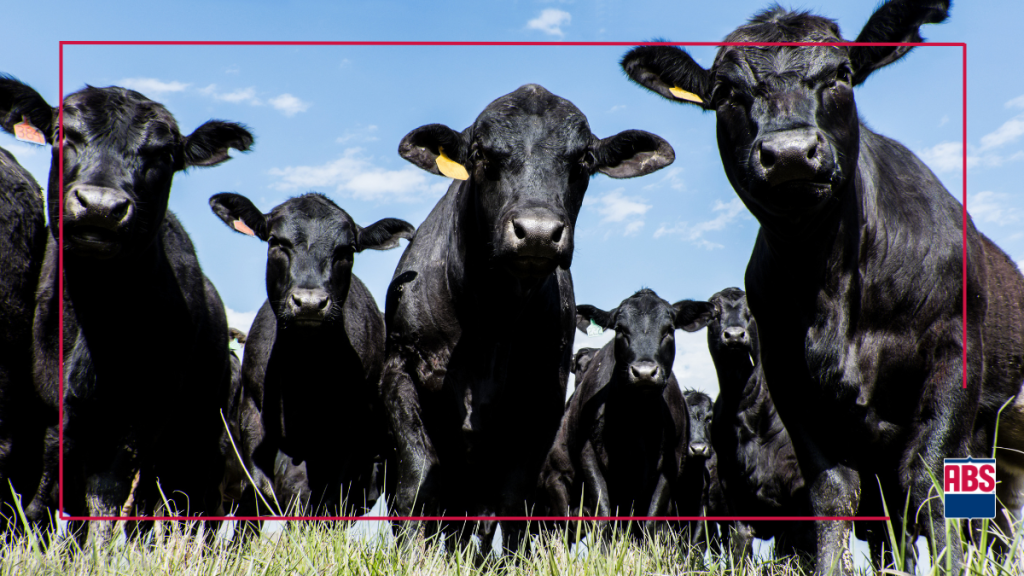Publish date: 4.09.24
Spring into synchronization! It’s that time of year again—beef producers need to start thinking about what estrus synchronization protocol they are going to use on their heifers and cows. With so many protocols to choose from, this task can seem daunting. Knowing this, this blog discusses the more commonly used protocols, as well as their respective benefits and limitations, to help make your selection process a bit easier.
The Beef Synchronization Protocols
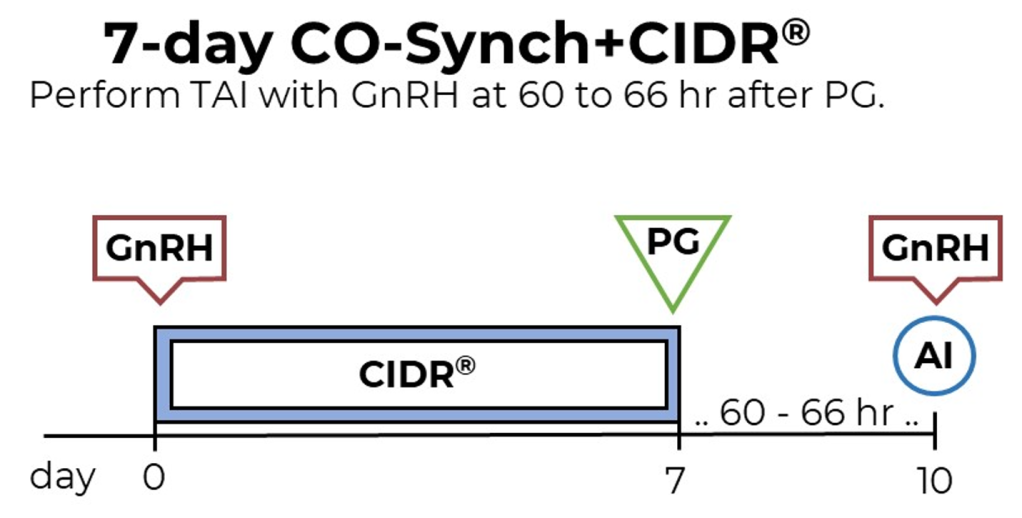
The 7-day CO-Synch + CIDR could be referred to as the ‘gold standard’ of protocols. With only 3 trips through the chute, you can have your females synchronized and artificially inseminated (AI) within 10 days. Over the years we have seen great results in both beef cows and heifers using this protocol, and it’s a perfect place to start if you have never synchronized your herd before. Heifers are fixed-time AI (TAI) at 54 ± 2 hours and cows are TAI at 60 to 66 hours after CIDR removal.
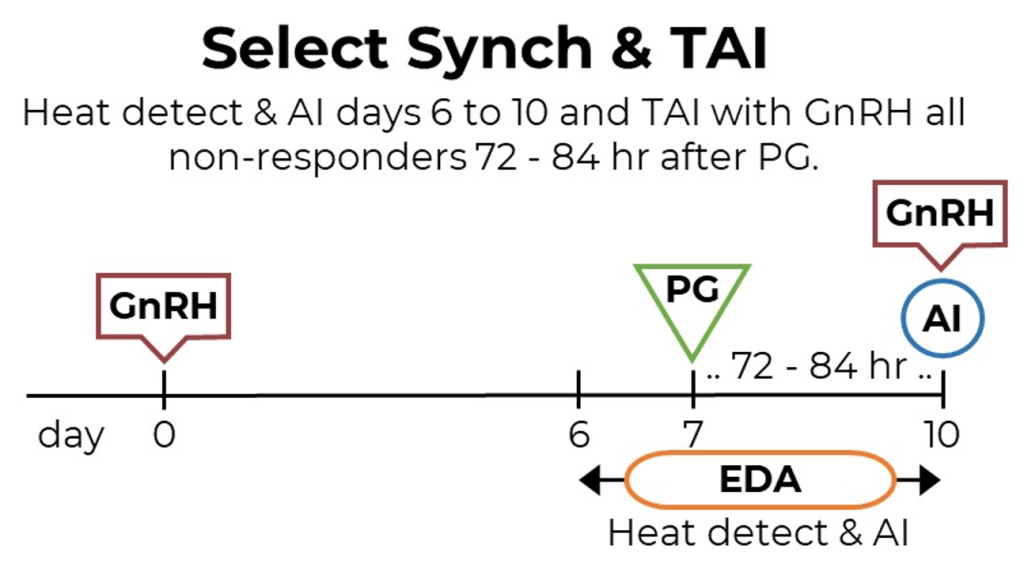
If you are looking for a way to cut down on estrus synchronization costs and you are able to do heat detection in your cow herd, this might be the protocol for you. Similar to the 7-day CO-Synch + CIDR protocol, you can have cows synchronized and bred within 10 days. An additional benefit is that you can cut out the cost of the CIDR. Nevertheless, you will need to perform heat detection from day 6 onwards because some cows will come into heat early without the progesterone from the CIDR insert and you definitely don’t want to miss them. Keep in mind that a CIDR insert is beneficial to postpartum cows, as it helps stimulate cyclicity. If you think a large proportion of your cow herd might not be cycling, using a protocol that incorporates a CIDR would be more beneficial. This protocol is not typically recommended for use in beef heifers due to the lack of a CIDR and its cyclicity-stimulating benefits.

If you are looking for the quickest way to synchronize, this might be the protocol for you. In only 8 days, females can be synchronized and AI. When compared to the 7-day CO-Synch + CIDR protocol, the 5-day CO-Synch + CIDR has been shown to result in greater pregnancy rates (Bridges et al., 2008, 2010). However, females do need to be handled twice on day 5 in order for them to receive the necessary dosage of prostaglandin (PG), which can add a hassle factor. Heifers are TAI at 60 ± 4 hours and cows are TAI at 72 ± 2 hours.
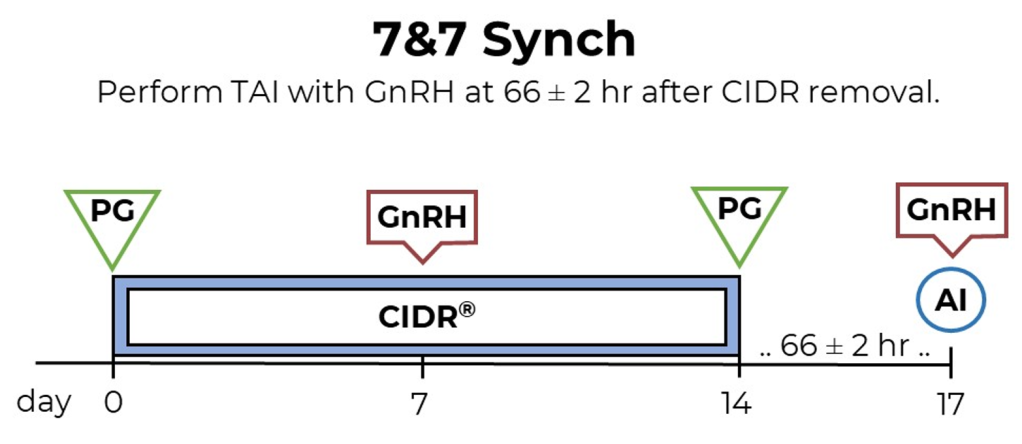
One of the newest synchronization protocols added to the protocol sheets, the 7&7 Synch has increased in popularity over the past few years. Heifers and cows are handled four times within 17 days and a CIDR insert is utilized for 14 days. With the first 3 injections taking place seven days from one another, this protocol is easy to plan and carry out. You can expect greater estrus expression and sometimes greater pregnancy rates when compared to the 7-day CO-Synch + CIDR protocol (Anderson et al., 2021; Mercadante et al., 2021). Heifers are TAI at 54 ± 2 hours and cows are TAI at 66 ± 2 hours. When using sexed semen, this is also a great choice.
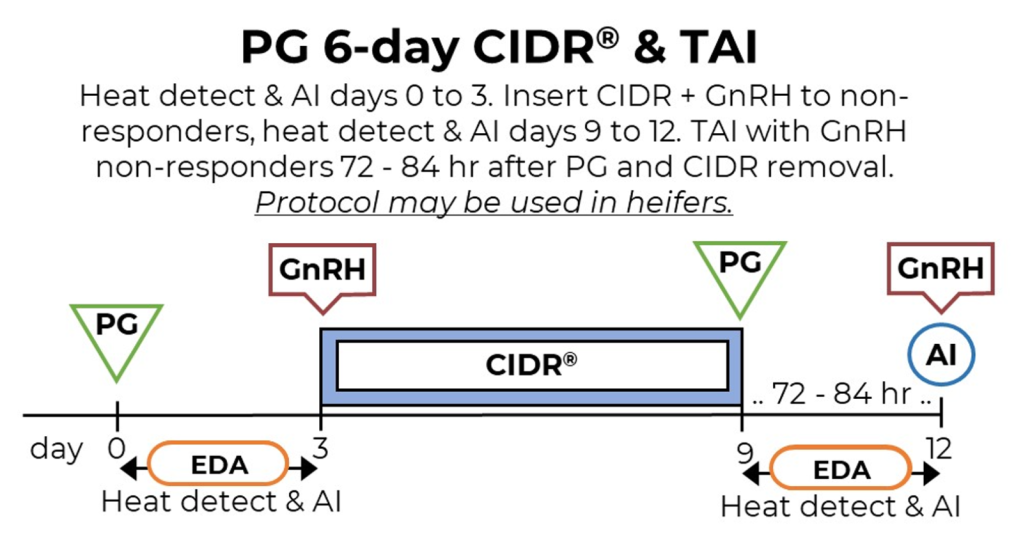
This is another protocol that requires heat detection, but it will definitely pay off. Females are handled four times within 12 days but have two chances to be bred to AI. After the initial PG injection, heat detection is performed for three days. All females that are bred during this time can then be sorted off and don’t need to receive a CIDR insert and the other hormones – a great way to cut down on costs. The CIDR remains in place for 6 days and then heat detection and AI is performed until the final TAI, which is only performed in females that did not show heat earlier during synchronization. This protocol achieves great results and can be used in both beef heifers and cows.

This protocol is only recommended for use in beef heifers and does an outstanding job. It does, however, take some advanced planning due to its length of 33 days. After the CIDR is removed there is a 16-day window before the injection of PG is administered. During this time some heifers may come into heat, but it is not recommended to breed them during this time as fertility would likely be lower. This protocol does require four trips through the chute, but they are spread out over a longer period of time. This protocol achieves above average pregnancy rates.

If you are able to feed heifers in a dry-lot setting, this might be the protocol you are looking for. This is another long-term protocol only recommended for beef heifers, where synchronization and TAI take place over a period of 36 days – so you definitely need to plan in advance. Like the 14-day CIDR-PG & TAI protocol, it’s not recommended to breed heifers that come into heat between MGA and the injection of PG due to the likelihood of decreased fertility of that first heat. Although it is a long protocol, you only need to handle the heifers through the chute twice, and MGA is much less expensive than a CIDR insert if you are trying to cut down on costs. You do need to be able to feed heifers everyday and need to make sure that they receive the correct dose of MGA for this protocol to be successful. Pregnancy rates are comparable to that of the 14-day CIDR-PG & TAI (Vraspir et al., 2014).
Synchronization Tips
- Make sure you stick to the recommended protocols on the protocol sheets and give the correct drug on the correct day
- Make sure that your needle length is correct for the intended route of administration
- Store your estrus synchronization hormones under the conditions recommended by the manufacturer
- Try to minimize stress during animal handling
- Make sure that you are being as clean as possible, especially when it comes to CIDR insertion and performing artificial insemination
There are a number of estrus synchronization protocols available, but it is always recommended to stick with protocols that are published on the Beef Reproduction Task Force’s protocol sheets. These protocols get updated every year so it’s important to make sure you are looking at the most up-to-date version.
For more information on the Beef Reproduction Task Force or estrus synchronization protocols, head to their website and click on the protocols heading on their home page.
Start using synchronization in your herd and experience the benefits by contacting your ABS Representative or completing the form below.




